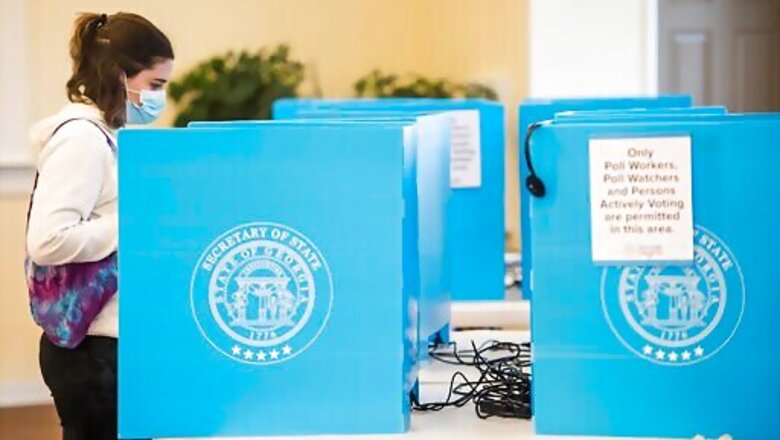
views
ATLANTA: President Donald Trump came to the north Georgia mountains Monday night to gin up turnout in conservative strongholds and stave off the Democratic challengers who threatened the GOPs Senate majority in two runoff elections.
It didn’t work.
Republicans’ overwhelming white, older and rural and exurban coalition failed the GOP Senate candidates in Tuesday’s high-stakes elections, while Democrats proved their alliance that succeeded in defeating Donald Trump in the state in November was not a fluke.
Black and young voters, suburbanites and the many recent arrivals to the state showed up a second time in two months to back Democrats, handing Jon Ossoff and Raphael Warnock narrow victories over Republicans David Perdue and Sen. Kelly Loeffler.
Across Georgia, a fast-growing, diversifying Deep South state, Tuesday’s election returns told the same story: Record runoff turnout — more than 4.4 million — didnt match the 5 million ballots cast in November, but Democrats consistently came closer than their rivals to replicating their November vote totals, even in the large towns where Trump rallied.
It was true in north Georgia’s Whitfield County, Trump territory, where Perdue and Loeffler got 89% of the votes that Perdue won in the general election, when he led all Senate candidates in the first round of voting. That would be an impressive showing in most runoffs, which almost invariably see a turnout drop. But Ossoff and Warnock managed slightly more than 90% of their November totals.
And it was true across the Atlanta suburbs, both the northern, whiter enclaves that have for two decades assured statewide victories for Republicans and the southern ring of communities where Black voters tilt the ledger to Democrats. Democrats also outperformed Republicans in metro Atlanta, the center of an ever-expanding footprint that has remade the Georgia economy and, now, its politics.
Behind the Democrats’ victories two months after Biden became the first Democrat since 1992 to win the states presidential electoral votes are a mix of factors: The double runoffs and their national consequences brought bottomless resources to a party infrastructure that had been expanding for years.
Black voters were driven by the possibility of Warnock becoming the states first Black senator, an achievement coveted even more coming two years after Democrat Stacey Abrams narrowly missed becoming the first Black female governor in U.S. history.
And Trump shadowed over it all as he sowed chaos within his party over his fraudulent claims of a rigged election and continued to repel college-educated suburbanites. Democrats narrowly edged out Republicans among that group, according to AP VoteCast, a survey of more than 3,700 Georgia voters.
Democrats argue their new path to power in Georgia will outlast the president.
Weve been building a multiracial, multiethnic, multigenerational statewide coalition truly a statewide coalition for years, said Lauren Groh-Wargo, who managed Abrams 2018 campaign and has been at the center of organizing work conducted by a range of groups on the left.
According to AP VoteCast, Democrats were competitive with the help of small but mighty groups in the diversifying state. Black voters 32% of the electorate in the runoff, according to the survey supported Ossoff and Warnock almost universally. VoteCast showed Black voters were 29% of the November electorate. That slight uptick could by itself account for tipping statewide results in a close Georgia election.
Voters in households earning under $50,000 are roughly 40% of voters in the state, and about 6 in 10 backed Democrats. And, even as Republicans hoped Loeffler might appeal to female voters, Democrats handily won majorities of women in cities and suburbs, Black and Latino women and college-educated women.
The racial divide in the state was stark. Sixty percent of voters were white, and about three-quarters of them backed Republicans. The GOP candidates won majorities of white voters with and without a college degree, across age groups and genders. Roughly two-thirds of small town and rural voters supported Loeffler and Perdue, including comparable shares of men and women. Voters who have lived in Georgia for more than 20 years about two-thirds of all voters slightly favored the GOP.
But it wasn’t enough in rapidly changing Georgia.
Since 2017, census figures show that roughly 280,000 people moved to to the state annually. That influx has steadily tilted the state away from Republicans. About 6 in 10 of voters who moved there within the past 20 years voted for the Democrats, VoteCast found.
That growth has pushed suburbs deeper into the state. The Atlanta area has expanded an average 61 square miles each year between 1990 and 2010, almost two times more than any other city in the country, according to economist Issi Romem. The rapid expansion caused Atlantas suburbs to become denser and more diverse, a pattern that favored improved margins for Democrats.
Roughly half of Georgias voters in the Senate runoffs identified as suburban; Democrats won this group 54% to 46%, according to VoteCast.
Republicans bemoaned those losses in places that once solidified GOP victories statewide.
Suburbs, my friends, the suburbs, wrote Josh Holmes, a former top aide to outgoing Senate Majority Leader Mitch McConnell, on Twitter. I feel like a one trick pony but here we are again. We went from talking about jobs and the economy to … election conspiracies in 4 short years and as it turns out they were listening!
By about 2 to 1, moderate voters favored Ossoff and Warnock, according to VoteCast.
Democrats have been mining Georgia’s suburbs for support for years and effectively capitalized on expanded mail and early voting opportunities this election season.
About 6 in 10 Georgia voters say they were contacted on behalf of Democratic candidates, compared with about half for Republican candidates, according to VoteCast. Democratic voters were roughly twice as likely as Republican voters to say they responded to the contact by receiving help with registering, planning when to vote or voting absentee.
The evidence showed up in the results.
Cherokee County, fast-growing suburbs and exurbs north of Atlanta, remains a deep trove of Republican votes, even as Democrats have upped their performance in years. But Loeffler and Perdue managed just 90% of Perdue’s November high mark of nearly 100,000 a net loss of more than 9,000 votes. Ossoff managed 94% of his November total, with Warnock a percentage point higher.
South of Atlanta is Clayton County, which has the highest proportion of Democratic votes in the metro area. Democrats’ raw vote totals there are often comparable to Republicans’ in Cherokee. On Tuesday, Ossoff and Warnock managed 96% of Democrats’ November total, losing only 3,500 votes. The Republicans matched less than 80%.
Groh-Wargo, the Democratic strategist and organizer, said the population growth and Democrats’ efforts across the state will intensify, not wane, after the victories.
The party that is reaching out and expanding across demographics, geography, figuring out how to connect with all voters, she said, the party thats doing that is going to be the ascendant party in Georgia and any diverse state.
___
Fingerhut reported from Washington, Boak from Baltimore.
Disclaimer: This post has been auto-published from an agency feed without any modifications to the text and has not been reviewed by an editor
Read all the Latest News, Breaking News and Coronavirus News here
















Comments
0 comment